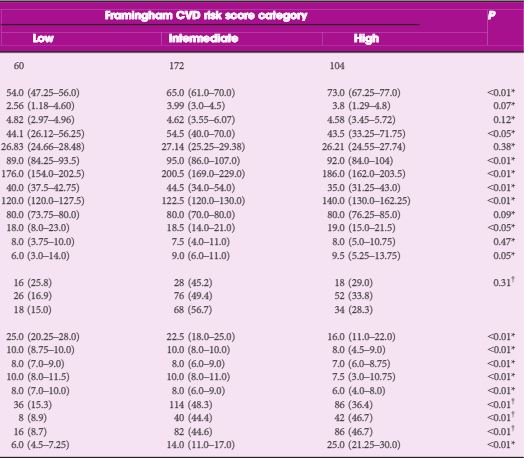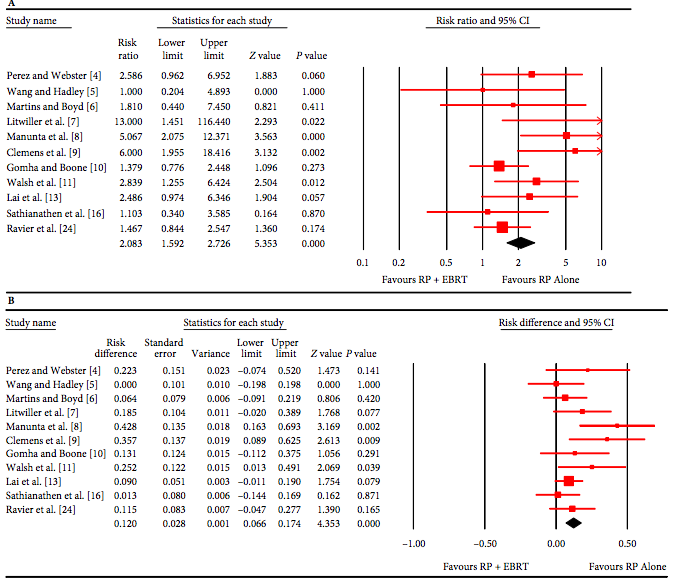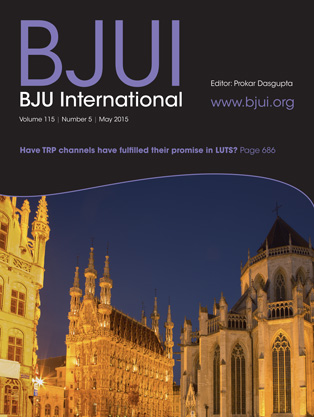
Editorial: Does a positive margin always mandate adjuvant radiotherapy?
The appropriate treatment for clinically localized prostate cancer continues to generate controversy. For men with low grade disease it is unclear whether surgery or radiation therapy provides a survival advantage over active surveillance, and among men with high grade disease it is unclear how many derive a substantial benefit from either intervention. No trial has yet to compare surgery and radiation with observation, but the recent update of the Scandinavian Prostate Cancer Group 4 study suggests…

Video: Postoperative RT for patients at high-risk of recurrence after RP: does timing matter?
Postoperative radiation therapy for patients at high-risk of recurrence after radical prostatectomy: does timing matter?
Charles C. Hsu*†, Alan T. Paciorek‡, Matthew R. Cooperberg‡, Mack Roach III*, I-Chow J. Hsu* and Peter R. Carroll‡
*Department of Radiation Oncology, Helen Diller Family Comprehensive Cancer Center, University of California at San Francisco, †Department of Radiation Oncology, College of Medicine, University of Arizona, Tucson, AZ, and ‡Department of…

Article of the Week: Increase of Framingham CVD risk score is associated with severity of LUTS
Every Week the Editor-in-Chief selects an Article of the Week from the current issue of BJUI. The abstract is reproduced below and you can click on the button to read the full article, which is freely available to all readers for at least 30 days from the time of this post.
In addition to the article itself, there is an accompanying editorial written by a prominent member of the urological community. This blog is intended to provoke comment and discussion and we invite you to use the comment…

Editorial: LUTS – an independent risk factor for CVD
Russo et al. [1] have identified LUTS as an independent risk factor for cardiovascular disease (CVD). The more severe the LUTS the more the CVD risk increased. LUTS in men is caused by a group of disorders, e.g. the metabolic syndrome and central obesity, which have similar risk factors to those that cause CVD [2]. Furthermore, LUTS is associated with erectile dysfunction (ED), which is well established as being linked to silent or symptomatic CVD [3]. The question arises as to whether the age…

Video: The severity of LUTS is associated with an increase of Framingham CVD risk score
Increase of Framingham cardiovascular disease risk score is associated with severity of lower urinary tract symptoms
Giorgio I. Russo, Tommaso Castelli, Salvatore Privitera, Eugenia Fragala, Vincenzo Favilla, Giulio Reale, Daniele Urzı, Sandro La Vignera*, Rosita A. Condorelli*, Aldo E. Calogero*, Sebastiano Cimino and Giuseppe Morgia
Department of Urology, and *Department of Medical and Paediatric Sciences, Section of Endocrinology, Andrology and Internal Medicine, University of…

Article of the Month: Effect of the Interval Between First and Second TUR on Outcomes in NMIBC
Every Month the Editor-in-Chief selects the Article of the Month from the current issue of BJUI. The abstract is reproduced below and you can click on the button to read the full article, which is freely available to all readers for at least 30 days from the time of this post.
In addition to the article itself, there is an accompanying editorial written by a prominent member of the urological community. This blog is intended to provoke comment and discussion and we invite you to use the…

Editorial: Is 42 days the ‘magic number’ for repeat TURBT?
Gökçe et al. [1] have evaluated a group of 242 patients from 10 centres with high-risk non-muscle-invasive bladder cancer (NMIBC) who underwent repeat resection and subsequent follow-up treatment, including induction and maintenance BCG for at least 1 year. They included patients who had repeat transurethral resection (TUR) within 90 days and excluded anyone who was upstaged to T2 or who did not complete 1 year of maintenance BCG. They divided patients into two groups according to time…

Video: Significance of time interval between first and second TUR on recurrence and progression rates in BCG-treated NMIBC
Significance of time interval between first and second transurethral resection on recurrence and progression rates in patients with high risk non muscle invasive bladder cancer treated with maintenance intravesical Bacillus Calmette-Guerin
Sumer Baltacı, Murat Bozlu*, Asıf Yıldırım†, Mehmet Ilker Gokce, İlker Tinay‡, Guven Aslan§, Cavit Can¶, Levent Turkeri‡,Ugur Kuyumcuoglu** and Aydın Mungan††
Department of Urology, Ankara University School of Medicine,…

Article of the Week: Complications following artificial urinary sphincter placement after RP and EBRT
Every Week the Editor-in-Chief selects an Article of the Week from the current issue of BJUI. The abstract is reproduced below and you can click on the button to read the full article, which is freely available to all readers for at least 30 days from the time of this post.
In addition to the article itself, there is an accompanying editorial written by a prominent member of the urological community. This blog is intended to provoke comment and discussion and we invite you to use the comment…

Editorial: Post-prostatectomy incontinence in the irradiated patient: more than just a drop in the ocean
Improved early detection of prostate cancer has led to an increased incidence of this disease, and an increase in the number of patients undergoing radical prostatectomy (RP). The rate of post-prostatectomy incontinence (PPI) is difficult to determine because of the varying definitions of incontinence, but approximately one in five men require the use of pads in the long term after RP. Incontinence has a significant negative impact on quality of life, and remains many men's greatest fear, especially…
